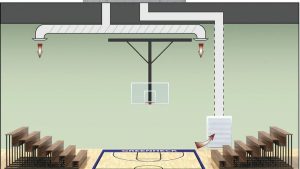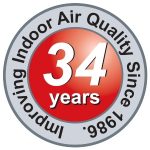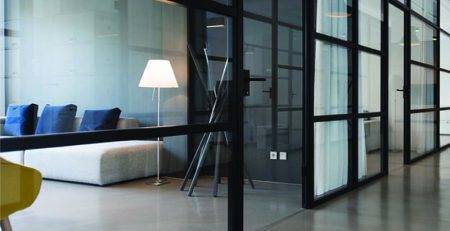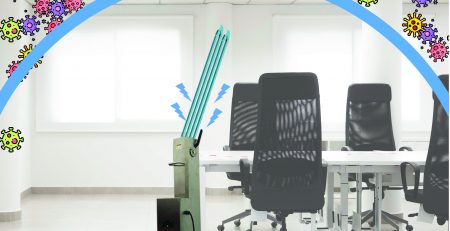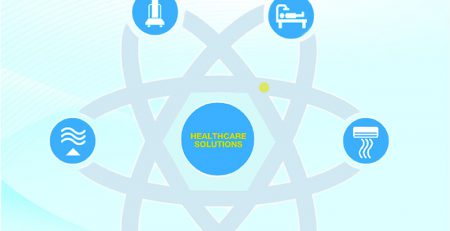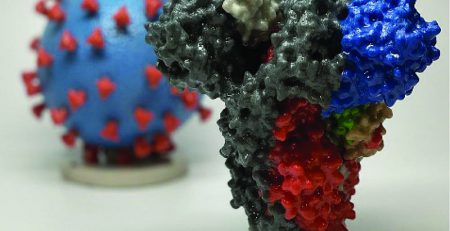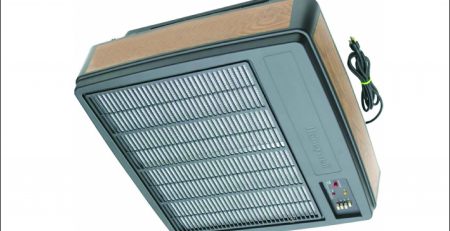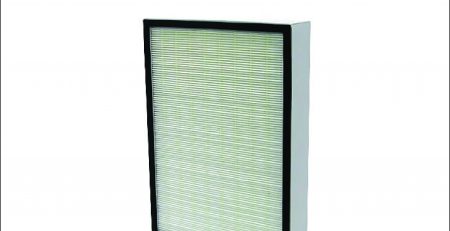Adjusting HVAC Ops to Help Mitigate COVID-19 Spread
Adjusting HVAC Ops to Help Mitigate COVID-19 Spread
Increased ventilation, improved ltration e ciency, and electronic air cleaning are the keys in both commercial and educational settings, writes Greenheck’s Nick Pearce.
DEC 09, 2020
By NICK PEARCE, Application Engineer, Greenheck, Schofield WI
In response to the COVID-19 pandemic, the American Society of Heating, Refrigerating and Air-Conditioning Engineers (ASHRAE) has published guidelines for HVAC system operation in commercial and educational buildings to help mitigate the spread of COVID-19 via airborne respiratory droplets. The guidelines fall into three general categories:
- Increased ventilation;
- Increasd filtration effiiency;
- Electronic air cleaners.
These HVAC system upgrades can pose challenges to building operation and energy usage. However, properly designed dedicated outdoor air systems (DOAS) and variable air volume (VAV) systems help minimize the challenges. DOAS and VAV systems provide high percentages of conditioned outdoor air into buildings. Many of the upgrades recommended by ASHRAE are easily implemented with these systems.
INCREASED VENTILATION
Increased ventilation dilutes the concentration of indoor contaminants, including infectious respiratory droplets, and mitigates the spread of COVID-19 via airborne transmission.1 DOAS and VAV systems are well suited for increased ventilation recommendations because each has features available to control and condition high percentages of outdoor air efficiently.
DOAS and VAV systems deliver conditioned outdoor air based on building occupancy levels. DOAS consists of two parallel systems, as shown in Figure 1.
 Figure 1: DOAS includes a dedicated ventilation unit and multiple AHUs
Figure 1: DOAS includes a dedicated ventilation unit and multiple AHUs
A dedicated ventilation unit provides 100% outdoor air and controls the latent load, while air handling units (AHUs) control the space sensible load. VAV systems mix high percentages of outdoor air with return air to maintain indoor temperature and humidity. Figure 2 shows a single-zone VAV system serving a gymnasium.
 Figure 2: A gymnasium served by a single-zone VAV system.
Figure 2: A gymnasium served by a single-zone VAV system.
Maintaining indoor relative humidity is key to controlling the spread of viruses.
Viruses have the most difficulty surviving in 40-60% relative humidity.1 DOAS and VAV systems maintain this humidity range across a wide range of outdoor conditions by offering modulating compressors, hot gas reheat, and head pressure control. Modulating compressors (digital scroll or variable speed) adjust capacity to match the cooling or dehumidification load. Modulating hot gas reheat maintains the desired relative humidity levels. Modulating head pressure control maintains a constant refrigerant pressure by modulating the condenser fan speed. In mild temperatures, this reduces the speed of the condenser fans to improve hot gas reheat performance.
OTHER VENTILATION RECOMMENDATIONS
Operate HVAC systems longer. Increase the time that HVAC systems operate in normal occupied mode. ASHRAE recommends up to 24/7 operation to prevent the buildup of infectious particles.1 This is an easy strategy to implement, as it only requires scheduling changes.
Implement a pre- and post-occupancy flush sequence. If 24/7 operation is not feasible, use an outdoor air flush sequence. This sequence involves flushing the building with the peak outdoor air rate before and after occupancy. ASHRAE recommends providing three outdoor air changes, meaning that the air in the space should be replaced completely three times. As an alternative to calculating the air change rate, flushing periods of two hours for pre- and post-occupancy is another option.2
Disable Demand Control Ventilation (DCV). DCV saves energy by reducing ventilation during periods of light occupancy. Disabling DCV maximizes outdoor air regardless of occupancy.1 Blowers should operate at the maximum design speeds, and the outdoor damper should remain at its maximum position.
Open outdoor air dampers on VAV systems. Open the outdoor air damper as much as cooling and heating capacities will allow while maintaining desired space conditions.1 Consider this strategy carefully before applying in humid or cold climates. Use caution in polluted areas, as increasing ventilation may introduce unwanted pollutants into the building. DOAS and VAV offer optional high-efficiency filters to reduce the amount of pollutants that enter the building.
Use energy recovery. The preceding ventilation recommendations increase ventilation and mitigate the spread of COVID-19. However, these strategies also increase energy usage. To reduce energy costs associated with ventilation, energy recovery can be incorporated into DOAS and VAV systems.
 Figure 3: Dedicated ventilation unit with an energy wheel that transfers energy between the outdoor and exhaust airstreams.
Figure 3: Dedicated ventilation unit with an energy wheel that transfers energy between the outdoor and exhaust airstreams.
Figure 3 shows a total energy wheel installed in a dedicated ventilation unit. Total energy wheels transfer sensible and latent energy between the outdoor and exhaust airstreams. In summer, the outdoor air is cooled and dehumidified as it passes through the wheel. The opposite occurs in winter; the outdoor air is heated and humidified. This preconditioning of the outdoor air reduces the cooling and heating loads, resulting in lower energy costs. ASHRAE recommends that energy recovery devices remain operating and are essential for maintaining ventilation rates during this pandemic.3
Existing DOAS and VAV systems can benefit from the addition of energy recovery. Adding an energy recovery device reduces the outdoor cooling and heating loads, allowing for increased ventilation while maintaining space conditions. Figure 4 shows an energy wheel installed in the outdoor air intake of an outdoor ventilation unit, with exhaust air being pulled through the wheel from a restroom.
INCREASED FILTRATION EFFICIENCY
ASHRAE recommends filters with a rating of MERV 13 or higher, which capture at least 85 percent of airborne respiratory droplets.4 Use MERV 13 and MERV 14 filters in VAV systems to capture infectious respiratory droplets from the return air. Highefficiency filters do not affect the spread of COVID-19 when used in DOAS ventilation
 Figure 4: An energy recovery wheel installed in the outdoor airstream of a VAV system reduces the mechanical cooling and heating loads.
Figure 4: An energy recovery wheel installed in the outdoor airstream of a VAV system reduces the mechanical cooling and heating loads.
units. These ventilation units provide 100% outdoor air, and thus no infectious respiratory droplets are recirculated from the space. The only time DOAS ventilation units could require high efficiency filters is in polluted areas.
ELECTRONIC AIR CLEANERS
In addition to the ventilation and filtration strategies outlined above, electronic air cleaning devices can supplement HVAC systems to clean indoor air and further mitigate the spread of COVID-19. Although several types of electronic air cleaners exist, the industry has focused on two in particular: ultraviolet lights and bipolar ionization. These technologies can be applied to VAV systems that handle a mixture of outdoor and return air. Electronic air cleaners do not affect the spread of COVID19 when used in DOAS ventilation units, which do not recirculate air from the space.
Ultraviolet (UV-C) Light
UV-C light can inactivate microorganisms. Although it has not yet been proven effective against COVID-19, it is effective against other coronaviruses.4 Therefore, ASHRAE recommends incorporating UV-C lights into HVAC systems.
The effectiveness of UV-C light against microorganisms is a function of exposure time multiplied by light intensity. It is commonly used for surface disinfection of cooling coils and drain pans. These components are kept free of mold and bacteria growth when irradiated with UV-C light. Low light intensities can be used due to the essentially infinite exposure times of the surfaces.5
Use of UV-C lights is possible for airstream disinfection, but this requires higher light intensities due to shorter exposure times of moving air. ASHRAE suggests a minimum 0.25 seconds of exposure time to avoid excessive light intensities and the associated high energy costs.5 The ability to meet this suggested exposure time in an AHU is dependent on physical space constraints and airstream velocity. If this is not possible, mounting the UV-C lights in the ductwork is another option. Avoid mounting UV-C lights near filters because the lights can burn holes in the filter media. Caution should be used while servicing these devices, as exposure to UV-C light may cause skin redness and eye irritation.6
Bipolar Ionization (BPI)
Building operators may consider using BPI, especially if other mitigation strategies are not feasible due to blower or tempering capacity limitations. BPI generates positively and negatively charged ions, which can inactivate airborne microorganisms by stripping them of hydrogen. The ions also cause airborne particulate to cluster together into larger masses that can be captured by filters.7 BPI devices come in varying sizes and are easily installed in VAV units.
Some BPI devices generate ozone as a by-product of their operation, which is harmful to human health and can cause respiratory problems. When selecting BPI, check if the device meets UL 2998, which validates that electronic air cleaners produce no ozone.8
CONCLUSION
As commercial and educational buildings reopen, simple HVAC system adjustments can help minimize the risk of airborne COVID-19 transmission. DOAS and VAV systems can efficiently meet ASHRAE’s recommendations for increased ventilation. High- efficiency filters and electronic air cleaners can further supplement the effect that DOAS and VAV systems have on mitigating the spread of COVID-19. Building owners can breathe a sigh of relief, knowing that their HVAC system operations are helping minimize the impact of COVID-19.
Upgrade Your HVAC System
Upgrade your HVAC system to incorporate high- percentage outdoor air units suitable for use in DOAS and VAV systems. Table 1 illustrates how specific features of these systems meet ASHRAE’s recommendations for mitigating the spread of COVID19.

REFERENCES
-
ASHRAE, “ASHRAE Position Document on Infectious Aerosols,” 14 April 2020.
[Online]. Available:
https://www.ashrae.org/file%20library/about/position%20documents/pd_infectio usaerosols_2020.pdf.
-
ASHRAE, “Building Readiness,” 2020. [Online]. Available: https://www.ashrae.org/technical-resources/building-readiness.
-
ASHRAE TC 5.5, “Practical Guidance for Epidemic Operation of Energy Recovery Ventilation Systems,” 9 June 2020. [Online]. Available:
https://www.ashrae.org/file%20library/technical%20resources/covid19/practical-guidance-for-epidemic-operation-of-ervs.pdf.
-
ASHRAE, “Filtration and Disinfection FAQ,” 2020. [Online]
Available: https://www.ashrae.org/technical-resources/filtration-anddisinfection-faq.
-
ASHRAE, “Ultraviolet Air and Surface Treatment,” [Online]. Available: https://www.ashrae.org/file%20library/technical%20resources/ covid19/si_a19_ch62uvairandsurfacetreatment.pdf. [Accessed 18 September 2020].
-
UV Resources, “UVC | Ultraviolet C Light | Frequently Asked Questions,” 2020.
[Online]. Available: http://www.uvresources.com/resources/faqs.
-
Waddell, “An Overview of Needlepoint Bipolar Ionization,” 28 February 2019. [Online]. Available: https://globalplasmasolutions.com/ uploads/customerresources/Service-Logic/GPS-WhitePaper-NPBI-Explained.pdf. [Accessed 16 September 2020].
-
ASHRAE, “ASHRAE Position Document on Filtration and Air Cleaning,” 29 January 2015. [Online]. Available: https://www.ashrae.org/file%20library/about/position%20documents/filtrationand-air-cleaning-pd.pdf.
Source: HPAC Engineering
Distributor of Electronic Air Cleaners and Ultraviolet Light in Malaysia:

56, Jalan 4, Kawasan Perindustrian Ringan,
Pandan Indah, 55100, Kuala Lumpur.
Hotline: 03 – 4295 3295
Website: www.aaq.com.my
Email: enquiry@aaq.com.my

